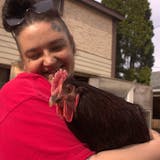On a lightly floured surface, roll the dough into a 15- by 15-inch square, lifting the dough occasionally to keep it from sticking to the surface. Spread the melted chocolate evenly over the dough, leaving a 1-inch-wide border at the top and a ½-inch border on the remaining three sides. Beginning with the bottom edge, roll up the dough jellyroll-style.
With the seam side down, roll it back and forth to seal the roll and extend its length to about 18 inches. Carefully begin twisting the log a few times until the seam appears as a gentle spiral down the length of the log. Bring together the two ends, pinching them together to seal, then give the doubled loaf another twist to make a figure 8 shape before placing in the pan, tucking under the pinched end.
Cover with a cloth and let rise at room temperature 1 to 2 hours or until the babka looks puffy and fills the pan.
For a Kranz cake shape (shown on the cover photo): Proceed as above to the point of rolling up the dough and extending its length to about 18 inches. With a sharp knife or metal scraper, cut the log down the middle lengthwise and carefully turn each piece cut side up. Place one piece over the other in an X, then crisscross the strands to make a braid, pinching together each end and tucking it beneath the babka.
Carefully place the braid on a sheet pan that's been greased or covered with parchment paper. Cover with a cloth and let rise at room temperature for 1 to 2 hours or until the braid looks puffy.
To bake: For either shape, preheat oven to 350 degrees. For the braid, bake for 20 minutes, then rotate the pan and lightly cover babka with foil. Bake for another 10-15 minutes. It will be quite brown. For a loaf, bake for 20 minutes, then rotate pan and lightly cover with foil. Bake another 20-25 minutes. It will be quite brown. Once baked, let the babka rest for 5 minutes before removing from the pans to a wire rack to cool. Babka is best served at room temperature.

